World Investment Report 2009: Transnational Corporations - Unctad
World Investment Report 2009: Transnational Corporations - Unctad
World Investment Report 2009: Transnational Corporations - Unctad
You also want an ePaper? Increase the reach of your titles
YUMPU automatically turns print PDFs into web optimized ePapers that Google loves.
CHAPTER I 7<br />
since the Second <strong>World</strong> War) has also reduced firms’<br />
propensity to invest in further expansion of production<br />
capacity, both domestically and internationally. The<br />
latest IMF forecasts envisage a decline in world<br />
output in <strong>2009</strong>, for the first time in 60 years. Total<br />
output in developed countries as a whole is expected<br />
to contract in <strong>2009</strong> by 3.8%, compared with a 0.8%<br />
rise in 2008 – the first such fall in the post-war period<br />
– while the growth rate in emerging and developing<br />
economies is likely to be lower, though still positive<br />
at 1.5%. The Organisation for Economic Co-operation<br />
and Development (OECD), the United Nations and<br />
the <strong>World</strong> Bank point to similar negative trends (table<br />
I.1).<br />
Risk aversion. Companies’ investment plans<br />
may also be scaled back due to a high level of<br />
perceived risks and uncertainties, in order to develop<br />
resilience to possible “worst-case” scenarios of<br />
financial and economic conditions. Many confidence<br />
indicators have fallen to historic lows – as exemplified,<br />
for instance, by the fall in the Ifo <strong>World</strong> Economic<br />
Climate Index, 6 the consumer confidence index of the<br />
Conference Board (United States) and the Euro Zone<br />
Economic Confidence Index. A large percentage of<br />
companies might implement cost-cutting programmes<br />
(including divestments, layoffs, and postponement<br />
or cancellation of investment projects) beyond what<br />
might be justified by the grim business outlook.<br />
An UNCTAD survey of firms’ investment<br />
prospects suggests that the investment plans of large<br />
TNCs have already been impacted significantly<br />
by the ongoing crisis (UNCTAD, <strong>2009</strong>b). 7 Of the<br />
TNCs responding to the survey, 85% reported that<br />
the economic downturn had a “negative” or “very<br />
negative” impact on their planned investment<br />
expenditures, and 79% and 47% reported “negative”<br />
Table I.1. <strong>World</strong> economic growth and growth prospects,<br />
2008–2010<br />
GDP (annual growth rate %)<br />
Source Region/economy a 2008 <strong>2009</strong> 2010<br />
IMF <strong>World</strong> 3.1 - 1.4 2.5<br />
of which:<br />
Advanced economies 0.8 - 3.8 0.6<br />
Developing and emerging economies 6.0 1.5 4.7<br />
<strong>World</strong> Bank <strong>World</strong> 1.9 - 1.7 2.3<br />
of which:<br />
High income countries 0.8 - 2.9 1.6<br />
Developing countries 5.8 2.1 4.4<br />
United Nations <strong>World</strong> 2.5 1.0 (baseline) ..<br />
of which:<br />
Developed economies 1.2 -0.5 (baseline) ..<br />
Developing economies 5.9 4.6 (baseline) ..<br />
Transition economies 6.9 4.8 (baseline) ..<br />
OECD OECD countries 0.8 - 4.1 0.7<br />
Source: IMF, <strong>2009</strong>a; <strong>World</strong> Bank, <strong>2009</strong>a; OECD, <strong>2009</strong> and United Nations, <strong>2009</strong>.<br />
a Each institution uses different classifications.<br />
Figure I.7. Impact of various aspects of the crisis<br />
on companies’ investment plans<br />
(Per cent of responses)<br />
���<br />
��<br />
��<br />
��<br />
��<br />
�<br />
�������<br />
��������� ������ ���<br />
������ ������<br />
Source: UNCTAD, <strong>2009</strong>b.<br />
������ ��������<br />
��������<br />
�������� ����<br />
������������<br />
���� �������� �������� ���� �������� ���� ��������<br />
or “very negative” impacts from the financial crisis<br />
and volatile exchange rates respectively (figure I.7).<br />
3. Key features of the FDI<br />
downturn and underlying factors<br />
The previous sections noted the overall decline<br />
in FDI flows and explained the transmission channels<br />
by which the economic and financial crisis has<br />
negatively impacted FDI. This section focuses on the<br />
key features of the downturn in terms of different FDI<br />
modes. It is important to have a good understanding<br />
of its causes, as different drivers call for different<br />
policy responses by host and home governments.<br />
FDI flows have fallen mainly for the following<br />
reasons:<br />
�� ��������������������������������������������������<br />
through cross-border M&As or greenfield projects,<br />
are falling; and<br />
�� ����������� 8 or other transfers of<br />
funds (e.g. repayments of debt, reverse<br />
loans) 9 from existing foreign affiliates<br />
to their parent firms are exceeding new<br />
investments by parent firms.<br />
a. The role of divestments<br />
Since the second or third quarter of<br />
2008, divestments, including repatriated<br />
investments, reverse intra-company loans<br />
and repayments of debt to parent firms, have<br />
exceeded gross FDI flows to several host<br />
countries for which data were available. This<br />
phenomenon has produced negative inflows<br />
in the balance-of-payments statistics of<br />
several developed countries (table I.2). For<br />
example, in Ireland and the United Kingdom,<br />
FDI inflows in the form of other capital<br />
(intra-company loans) turned negative in<br />
2008, although for the latter they improved

















